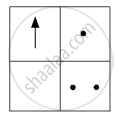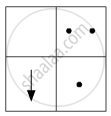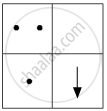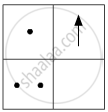Advertisements
Advertisements
Question
Find the position and nature of the image of an object 5 cm high and 10 cm in front of a convex lens of focal length 6 cm.
Solution
Given:
Height of the object, h = 5 cm
Object distance, u = -10 cm
Focal length, f = 6 cm
Applying lens formula, we get:
1/v - 1/u = 1/f (v = Image distance)
1/v - 1/( -10) = 1/6
or, v = 15 cm
Thus, the image is formed at a distance of 15 cm behind the convex lens (on the right side).
Now
Magnification, m = v/u = h'/h
m = 15/(-10)
m =-1.5
The value of magnification is negative; therefore, the image will be real and inverted.
APPEARS IN
RELATED QUESTIONS
If you focus the image of a distant object, whose shape is given below, on a screen using a convex lens, the shape of the image of this object on the screen would be:

(a)
(b)
(c)
(d)
Complete the following table:
| Instrument | Number of Convex Lenses |
Use |
| Simple Microscope | .............. | .............. |
| Compound Microscope | .............. | .............. |
| Telescope | .............. | .............. |
What type of lens would you use as a magnifying glass? How close must the object be to the lens?
An object is placed at a distance equal to 2f in front of a convex lens. Draw a labelled ray diagram to show the formation of image. State two characteristics of the image formed.
How could you find the focal length of a convex lens rapidly but approximately?
State whether convex lens has a real focus or a virtual focus.
What kind of lens can form:
an inverted magnified image?
A converging lens forms the image of an object placed in front of it, beyond 2F2 of the lens. Draw a ray diagram to show the formation of the image.
_______ is a combination of two convex lenses with small focal length.
Distinguish between Concave lens and Convex Lens.
